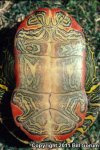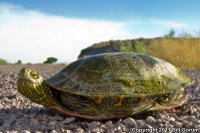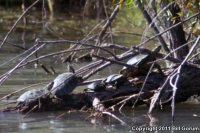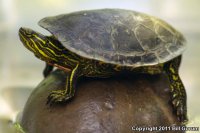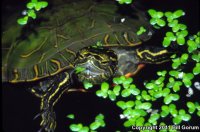| Range: |
 |
| Other Names: |
Painted Turtle |
| Subspecies: |
Western Painted Turtle Chrysemys picta belli |
| Description: |
2.5 - 10 inches in shell length (6.3 - 25.4 cm). A small turtle with red markings on the marginals and a smooth, oval, somewhat flattened keelless carapace which is black, brown, or olive in color with a network of faint light lines and olive, yellowish, or red borders along front edge of the shields. The posterior rim of the carapace has a smooth (not serrated) border.
The limbs and head are black to olive and marked with yellow lines.
Yellow stripes extend rearward from underneath the eyes and often from below the jaw.
The upper jaw is notched in front.
The unhinged plastron is reddish with a large dark mark in the center which branches out between the scutes. |
| Similar Species: |
Pond Sliders usually have no red markings on the shell and the rear margin of the carapace is serrated rather than smooth. The Big Bend Slider also has a notched upper jaw but the the rear of the carapace has a serrated margin. Mud turtles (including Yellow and Sonoran) have a double hinged plastron and lack red markings. |
| Habitat: |
Ponds, marshes, lakes, ditches, quiet streams with sandy or muddy bottoms and aquatic vegetation |
| Behavior: |
Aquatic and diurnal. Sleeps at night on the bottom or on a partially submerged object. Probably active all year long in the south but inactive during cold periods. Often seen basking on rocks, logs, or dirt banks, sometimes in large groups. Relatively cold-tolerant. In some areas, they can be observed swimming under ice just before it melts in March. Don't Pick up a Turtle Just Because You Find it Walking On Land! Turtles sometimes leave the water to search for food, more water, or to lay their eggs in the spring - typically March to June. If you see a turtle walking on the land, it is most likely not sick, so you should leave it alone. Many concerned people who think they are helping a turtle by picking it up and bringing it to a wildlife rehabilitation center are actually harming it by removing it from the wild unnecessarily. |
| Hibernation: |
In the north, probably hibernates beginning in late fall, emerging in March or April. |
| Reproduction: |
Becomes sexually mature when it reaches the appropriate size, typically in 3 - 6 years.
Breeds from March to June.
When the environmental conditions are just right, the female digs a nest at a sunny site near water in loose soil, anytime between May and August. Hot weather and drought can cause her to delay her nesting for a few weeks.
She lays from one to 23 eggs.
Egg incubated naturally in a Painted Turtle nest observed in Pennsylvania took 72 - 80 days to hatch. |
| Diet: |
An omnivorous generalist - eating almost anything found in its habitat, including insects, worms, snails, crayfish, fish, amphibians and tadpoles, carrion, and aquatic vegetation. Young are carnivorous, but become more herbivorous as they grow older. |
Adapted from californiaherps.com
Sources:


|



